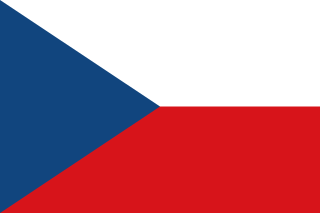
The Czech Republic, also known by its short-form name, Czechia, is a landlocked country in Central Europe bordered by Germany to the west, Austria to the south, Slovakia to the east and Poland to the northeast. The Czech Republic covers an area of 78,866 square kilometres (30,450 sq mi) with a mostly temperate continental climate and oceanic climate. It is a unitary parliamentary republic, with 10.6 million inhabitants; its capital and largest city is Prague, with 1.3 million residents. Other major cities are Brno, Ostrava, Olomouc and Pilsen. The Czech Republic is a member of the European Union (EU), NATO, the OECD, the United Nations, the OSCE, and the Council of Europe.

The Central African Republic is a landlocked country in Central Africa. It is bordered by Chad to the north, Sudan to the northeast, South Sudan to the east, the Democratic Republic of the Congo to the south, the Republic of the Congo to the southwest and Cameroon to the west. The CAR covers a land area of about 620,000 square kilometres (240,000 sq mi) and had an estimated population of around 4.6 million as of 2016.

The Dominican Republic is a country located in the island of Hispaniola, in the Greater Antilles archipelago of the Caribbean region. It occupies the eastern five-eighths of the island, which it shares with the nation of Haiti, making Hispaniola one of two Caribbean islands, along with Saint Martin, that are shared by two sovereign states. The Dominican Republic is the second-largest Caribbean nation by area at 48,671 square kilometers (18,792 sq mi), and third by population with approximately 10 million people, of which approximately three million live in the metropolitan area of Santo Domingo, the capital city.
A republic is a form of government in which the country is considered a “public matter”, not the private concern or property of the rulers. The primary positions of power within a republic are not inherited, but are attained through democracy, oligarchy or autocracy. It is a form of government under which the head of state is not a monarch.

The United Nations member states are the 193 sovereign states that are members of the United Nations (UN) and have equal representation in the UN General Assembly. The UN is the world's largest intergovernmental organization.

Yugoslavia was a country in Southeastern and Central Europe for most of the 20th century. It came into existence after World War I in 1918 under the name of the Kingdom of Serbs, Croats and Slovenes by the merger of the provisional State of Slovenes, Croats and Serbs with the Kingdom of Serbia, and constituted the first union of the South Slavic people as a sovereign state, following centuries in which the region had been part of the Ottoman Empire and then Austria-Hungary. Peter I of Serbia was its first sovereign. The kingdom gained international recognition on 13 July 1922 at the Conference of Ambassadors in Paris. The official name of the state was changed to Kingdom of Yugoslavia on 3 October 1929.

The Russian Soviet Federative Socialist Republic, previously known as the Russian Soviet Republic and the Russian Socialist Federative Soviet Republic, as well as being unofficially known as the Russian Federation, Soviet Russia, or simply Russia, was an independent state from 1917 to 1922, and afterwards the largest, most populous and most economically developed of the 15 Soviet socialist republics of the Soviet Union (USSR) from 1922 to 1991, then a sovereign part of the Soviet Union with priority of Russian laws over Union-level legislation in 1990 and 1991, during the last two years of the existence of the USSR. The Russian Republic comprised sixteen smaller constituent units of autonomous republics, five autonomous oblasts, ten autonomous okrugs, six krais and forty oblasts. Russians formed the largest ethnic group. The capital of the Russian SFSR was Moscow and the other major urban centers included Leningrad, Novosibirsk, Yekaterinburg, Nizhny Novgorod and Samara.

Zographus regalis is a species of beetle belonging to the family Cerambycidae.

Zographus oculator, the Orange-eyed Long-horn Beetle, is a species of flat-faced longhorn beetles belonging to the family Cerambycidae.
Sternotomini is a tribe of longhorn beetles of the Lamiinae subfamily. It was described by Thomson in 1860.
Zographus aulicus is a species of beetle in the family Cerambycidae. It was described by Bertoloni in 1849. It has a wide distribution in Africa.
Zographus cingulatus is a species of beetle in the family Cerambycidae. It was described by Per Olof Christopher Aurivillius in 1913. It is known from the Democratic Republic of the Congo, Angola, and Malawi.
Zographus lineatus is a species of beetle in the family Cerambycidae. It was described by Quedenfeldt in 1882, originally under the genus Quimalanca. It has a wide distribution in Africa.
Zographus nitidus is a species of beetle in the family Cerambycidae. It was described by Per Olof Christopher Aurivillius in 1914, originally Quimalanca. It is known from Uganda and the Democratic Republic of the Congo.
Zographus niveisparsus is a species of beetle in the family Cerambycidae. It was described by Louis Alexandre Auguste Chevrolat in 1844, originally under the genus Sternotomis. It is known from South Africa, Mozambique, and Zimbabwe.
Zographus plicaticollis is a species of beetle in the family Cerambycidae. It was described by James Thomson in 1868. It is known from South Africa and Namibia.
Zographus pulverulentus is a species of beetle in the family Cerambycidae. It was described by Nonfried in 1906, originally as a varietas of Zographus aulicus. It is known from the Democratic Republic of the Congo and South Africa.
Zographus quadrimaculatus is a species of beetle in the family Cerambycidae. It was described by E. Forrest Gilmour in 1956. It is known from Tanzania.
Zographus scabricollis is a species of beetle in the family Cerambycidae. It was described by Quedenfeldt in 1882, originally under the genus Quimalanca. It has a wide distribution in Africa.








